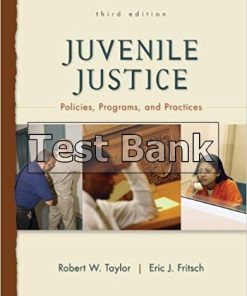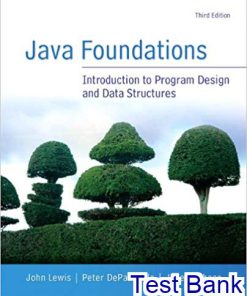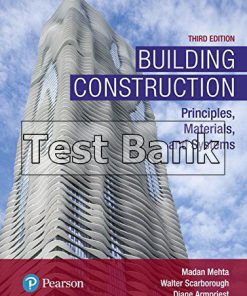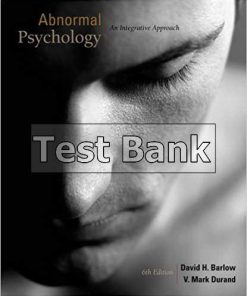Building Java Programs 3rd Edition Reges Test Bank
You may also like
Instant download Building Java Programs 3rd Edition Reges Test Bank pdf docx epub after payment.
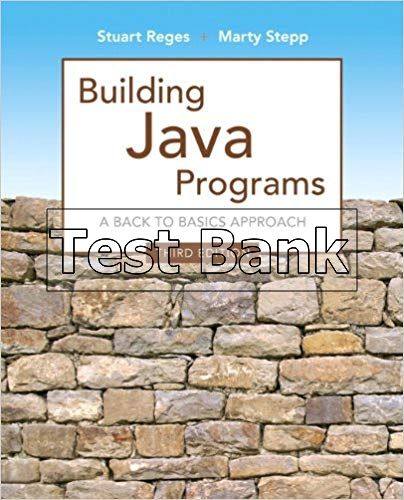
Product details:
- ISBN-10 : 0133360903
- ISBN-13 : 978-0133360905
- Author:
Building Java Programs: A Back to Basics Approach, Third Edition, introduces novice programmers to basic constructs and common pitfalls by emphasizing the essentials of procedural programming, problem solving, and algorithmic reasoning. By using objects early to solve interesting problems and defining objects later in the course, Building Java Programs develops programming knowledge for a broad audience.
Table of contents:
Chapter 1: Introduction to Java Programming
- 1.1 Basic Computing Concepts
- Why Programming?
- Hardware and Software
- The Digital Realm
- Why Java?
- The Process of Programming
- The Java Programming Environment
- 1.2 And Now–Java
- String Literals (Strings)
- System.out.println
- Escape Sequences
- print versus println
- Identifiers and Keywords
- A Complex Example: DrawFigures1
- Comments and Readability
- 1.3 Program Errors
- Syntax Errors
- Logic Errors (bugs)
- 1.4 Procedural Decomposition
- Static Methods
- Flow of Control
- Methods That Call Other Methods
- An Example Runtime Error
- 1.5 Case Study: DrawFigures
- Structured Version
- Final Version without Redundancy
- Analysis of Flow of Execution
Chapter 2: Primitive Data and Definite Loops
- 2.1 Basic Data Concepts
- Primitive Types
- Expressions
- Literals
- Arithmetic Operators
- Precedence
- Mixing Types and Casting
- 2.2 Variables
- Assignment/Declaration Variations
- String Concatenation
- Increment/Decrement Operators
- Variables and Mixing Types
- 2.3 The for Loop
- Tracing for Loops
- for Loop Patterns
- Nested for Loops
- 2.4 Managing Complexity
- Scope
- Pseudocode
- Class Constants
- 2.5 Case Study: A Complex Figure
- Problem Decomposition and Pseudocode
- Initial Structured Version
- Adding a Class Constant
- Further Variations
Chapter 3: Introduction to Parameters and Objects
- 3.1 Parameters
- The Mechanics of Parameters
- Limitations of Parameters
- Multiple Parameters
- Parameters Versus Constants
- Overloading of Methods
- 3.2 Methods that Return Values
- The Math Class
- Defining Methods that Return Values
- 3.3 Using Objects
- String Objects
- Interactive Programs and Scanner Objects
- Sample Interactive Program
- 3.4 Case Study: Projectile Trajectory
- Unstructured Solution
- Structured Solution
Supplement 3G: Graphics
- 3G.1 Introduction to Graphics
- DrawingPanel
- Drawing Lines and Shapes
- Colors
- Drawing with Loops
- Text and Fonts
- 3G.2 Procedural Decomposition with Graphics
- A Larger Example: DrawDiamonds
- 3G.3 Case Study: Pyramids
- Unstructured Partial Solution
- Generalizing the Drawing of Pyramids
- Complete Structured Solution
Chapter 4: Conditional Execution
- 4.1 if/else Statements
- Relational Operators
- Nested if/else Statements
- Object Equality
- Factoring if/else Statements
- Multiple Conditions
- 4.2 Cumulative Algorithms
- Cumulative Sum
- Min/Max Loops
- Cumulative Sum with if
- Roundoff Errors
- 4.3 Text Processing
- The char Type
- char versus int
- Cumulative Text Algorithms
- System.out.printf
- 4.4 Methods with Conditional Execution
- Preconditions and Postconditions
- Throwing Exceptions
- Revisiting Return Values
- Reasoning about Paths
- 4.5 Case Study: Body Mass Index
- One-person Unstructured Solution
- Two-person Unstructured Solution
- Two-person Structured Solution
- Procedural Design Heuristics
Chapter 5: Program Logic and Indefinite Loops
- 5.1 The while Loop
- A Loop to Find the Smallest Divisor
- Random Numbers
- Simulations
- The do/while Loop
- 5.2 Fencepost Algorithms
- Sentinel Loops
- Fencepost with if
- 5.3 The boolean Type
- Logical Operators
- Short-Circuited Evaluation
- boolean Variables and Flags
- Boolean Zen
- Negating Boolean Expressions
- 5.4 User Errors
- Scanner Lookahead
- Handling User Errors
- 5.5 Assertions and Program Logic
- Reasoning About Assertions
- A Detailed Assertions Example
- 5.6 Case Study: NumberGuess
- Initial Version without Hinting
- Randomized Version with Hinting
- Final Robust Version
Chapter 6: File Processing
- 6.1 File Reading Basics
- Data, Data Everywhere
- File Basics
- Reading a File with a Scanner
- 6.2 Details of Token-Based Processing
- Structure of Files and Consuming Input
- Scanner Parameters
- Paths and Directories
- A More Complex Input File
- 6.3 Line-Based Processing
- String Scanners and Line/Token Combinations
- 6.4 Advanced File Processing
- Output Files with PrintStream
- Guaranteeing that Files Can Be Read
- 6.5 Case Study: ZIP Code Lookup
Chapter 7: Arrays
- 7.1 Array Basics
- Constructing and Traversing an Array
- Accessing an Array
- A Complete Array Program
- Random Access
- Arrays and Methods
- The For-Each Loop
- Initializing Arrays
- The Arrays Class
- 7.2 Array Traversal Algorithms
- Printing an Array
- Searching and Replacing
- Testing for Equality
- Reversing an Array
- String Traversal Algorithms
- 7.3 Reference Semantics
- Multiple Objects
- 7.4 Advanced Array Techniques
- Shifting Values in an Array
- Arrays of Objects
- Command Line Arguments
- Nested Loop Algorithms
- 7.5 Multidimensional Arrays
- Rectangular Two-Dimensional Arrays
- Jagged Arrays
- 7.6 Case Study: Benford’s Law
- Tallying values
- Completing the Program
Chapter 8: Classes
- 8.1 Object-Oriented Programming
- Classes and Objects
- Point Objects
- 8.2 Object State and Behavior
- Object State: Fields
- Object Behavior: Methods
- The Implicit Parameter
- Mutators and Accessors
- The toString Method
- 8.3 Object Initialization: Constructors
- The Keyword this
- Multiple Constructors
- 8.4 Encapsulation
- Private Data Fields
- Class Invariants
- Changing Internal Implementations
- 8.5 Case Study: Designing a Stock Class
- Object-Oriented Design Heuristics
- Stock Fields and Method Headers
- Stock Method and Constructor Implementation
Chapter 9: Inheritance and Interfaces
- 9.1 Inheritance Basics
- Non-programming Hierarchies
- Extending a Class
- Overriding Methods
- 9.2 Interacting with the Superclass
- Calling Overridden Methods
- Accessing Inherited Fields
- Calling a Superclass’s Constructor
- DividendStock Behavior
- The Object Class
- The equals Method
- The instanceof Keyword
- 9.3 Polymorphism
- Polymorphism Mechanics
- Interpreting Inheritance Code
- Interpreting Complex Calls
- 9.4 Inheritance and Design
- A Misuse of Inheritance
- Is-a versus Has-a Relationships
- Graphics2D
- 9.5 Interfaces
- An Interface for Shapes
- Implementing an Interface
- Benefits of Interfaces
- 9.6 Case Study: Financial Class Hierarchy
- Designing the Classes
- Redundant Implementation
- Abstract Classes
Chapter 10: ArrayLists
- 10.1 ArrayLists
- Basic ArrayList Operations
- ArrayList Searching Methods
- A Complete ArrayList Program
- Adding to and Removing from an ArrayList
- Using the For-Each Loop with ArrayLists
- Wrapper Classes
- 10.2 The Comparable Interface
- Natural Ordering and compareTo
- Implementing the Comparable Interface
- 10.3 Case Study: Vocabulary Comparison
- Some Efficiency Considerations
- Version 1: Compute Vocabulary
- Version 2: Compute Overlap
- Version 3: Complete Program
Chapter 11: Java Collections Framework
- 11.1 Lists
- Collections
- LinkedList versus ArrayList
- Iterators
- Abstract Data Types (ADTs)
- LinkedList Case Study: Sieve
- 11.2 Sets
- Set Concepts
- TreeSet versus HashSet
- Set Operations
- Set Case Study: Lottery
- 11.3 Maps
- Basic Map Operations
- Map Views (keySet and values)
- TreeMap versus HashMap
- Map Case Study: WordCount
- Collection Overview
Chapter 12: Recursion
- 12.1 Thinking Recursively
- A Nonprogramming Example
- An Iterative Solution Converted to Recursion
- Structure of Recursive Solutions
- 12.2 A Better Example of Recursion
- Mechanics of Recursion
- 12.3 Recursive Functions and Data
- Integer Exponentiation
- Greatest Common Divisor
- Directory Crawler
- Helper Methods
- 12.4 Recursive Graphics
- 12.5 Recursive Backtracking
- A Simple Example: Traveling North/East
- 8 Queens Puzzle
- Solving Sudoku Puzzles
- 12.6 Case Study: Prefix Evaluator
- Infix, Prefix and Postfix Notation
- Evaluating Prefix Expressions
- Complete Program
Chapter 13: Searching and Sorting
- 13.1 Searching and Sorting in the Java Class Libraries
- Binary Search
- Sorting
- Shuffling
- Custom Ordering with Comparators
- 13.2 Program Complexity
- Empirical Analysis
- Complexity Classes
- 13.3 Implementing Searching and Sorting Algorithms
- Sequential Search
- Binary Search
- Recursive Binary Search
- Searching Objects
- Selection Sort
- 13.4 Case Study: Implementing Merge Sort
- Splitting and Merging Arrays
- Recursive Merge Sort
- Complete Program
Chapter 14: Stacks and Queues
- 14.1 Stack/Queue Basics
- Stack Concepts
- Queue Concepts
- 14.2 Common Stack/Queue Operations
- Transferring Between Stacks and Queues
- Sum of a Queue
- Sum of a Stack
- 14.3 Complex Stack/Queue Operations
- Removing Values from a Queue
- Comparing Two Stacks for Similarity
- 14.4 Case Study: Expression Evaluator
- Splitting into Tokens
- The Evaluator
Chapter 15: Implementing a Collection Class
- 15.1 Simple ArrayIntList
- Adding and Printing
- Thinking about Encapsulation
- Dealing with the Middle of the List
- Another Constructor and a Constant
- Preconditions and Postconditions
- 15.2 A More Complete ArrayIntList
- Throwing Exceptions
- Convenience Methods
- 15.3 Advanced Features
- Resizing When Necessary
- Adding an Iterator
- 15.4 ArrayList<E>
Chapter 16: Linked Lists
- 16.1 Working with Nodes
- Constructing a List
- List Basics
- Manipulating Nodes
- Traversing a List
- 16.2 A Linked List Class
- Simple LinkedIntList
- Appending add
- The Middle of the List
- 16.3 A Complex List Operation
- Inchworm Approach
- 16.4 An IntList Interface
- 16.5 LinkedList<E>
- Linked List Variations
- Linked List Iterators
- Other Code Details
Chapter 17: Binary Trees
- 17.1 Binary Tree Basics
- Node and Tree Classes
- 17.2 Tree Traversals
- Constructing and Viewing a Tree
- 17.3 Common Tree Operations
- Sum of a Tree
- Counting Levels
- Counting Leaves
- 17.4 Binary Search Trees
- The Binary Search Tree Property
- Building a Binary Search Tree
- The Pattern x = change(x)
- Searching the Tree
- Binary Search Tree Complexity
- 17.5 SearchTree<E>
Chapter 18: Advanced Data Structures
- 18.1 Hashing
- Array Set Implementations
- Hash Functions and Hash Tables
- Collisions
- Rehashing
- Hashing Non-Integer Data
- Hash Map Implementation
- 18.2 Priority Queues and Heaps
- Priority Queues
- Introduction to Heaps
- Removing from a Heap
- Adding to a Heap
- Array Heap Implementation
- Heap Sort
Appendix A: Java Summary
- Java Keywords
- Primitive Types
- Operators
- Wrapper Classes
- Syntax Templates
- Useful Methods of ArrayList, Character, Collection, Collections, DrawingPanel, File, Graphics, Iterator, Map, Math, Object, Point, Random, Scanner, String
Appendix B: Javadoc Comments and the Java API Specification
- The Java API Specification
- Writing Javadoc Comments
Appendix C: Additional Java Syntax
- Primitive Types byte, short, long, float
- Ternary Operator ? :
- Exiting a Loop: break and continue
- The switch Statement
- The try/catch Statement
- The assert Statement
- Enumerations: enum
- Packages
- Protected and Default Access
Index
People also search:
Building Java Programs 3rd Edition
Building Java Programs 3rd Edition pdf
Building Java Programs
|
java logic building programs
|
building java programs a back to basics approach github
basic logic building programs in java


